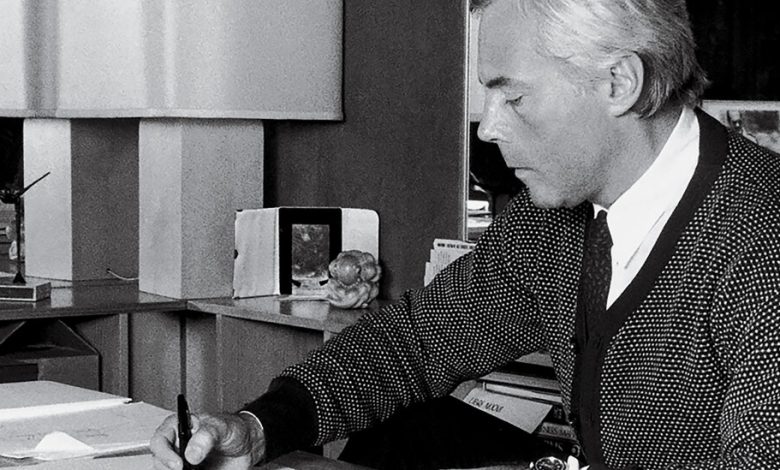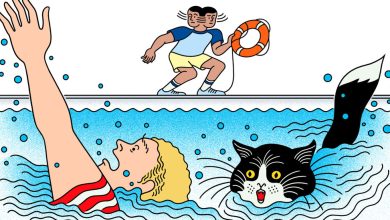Giorgio Armani’s Life in Pictures

Giorgio Armani, arguably the most recognizable name in fashion, was born in 1934 in the northern Italian town of Piacenza, roughly 40 miles southeast of Milan on the swampy banks of the Po River. “As a child, and then as a teenager,” he says, “I wasn’t aware of the fashion industry, simply because the Italian fashion phenomenon had yet to happen.” Instead, Armani enrolled in 1953 at the University of Milan to become a doctor. He dropped out after three years to join the army and was later hired as a window dresser at the Milanese department store Rinascente. “One of my first fashion jobs was working alongside Nino Cerruti, who was a weaver who also had his own clothing line,” Armani says. It was there that he learned the intricacies of textile making, spending time in a weaving factory to improve his craft.
In the following years, Armani worked for established houses such as Valentino and Zegna, founding his namesake brand in Milan in 1975 with Sergio Galeotti, his partner in business and in life, who died 10 years later. Armani’s first garment under his new label was a deconstructed men’s jacket, which had none of the era’s rigid lining or superfluous padding. “It was designed for me and for men like me, who no longer recognized themselves in the stiff formality of the previous generation,” he says of his drapey blazers and lightweight suiting. At the time, he says, silk and linen “were considered feminine materials — I proved the opposite.” A pared-back, stylishly rumpled Armani suit soon became the de facto uniform for cosmopolitan men and women of the 1980s, and the designer quickly rose to global fame. In 1981, he opened his first flagship in Milan, where he still lives, followed by several more in Asia and North America; he went on to launch diffusion lines (Armani Exchange in 1991 and the housewares brand Armani Casa in 2000), hotels (in Dubai and Milan) and more than 20 restaurants worldwide.
Now 88, Armani has become synonymous with Milanese style: restrained, rarefied and meticulous. But despite the reach of his empire, he insists it was never planned. “I prefer to seize opportunities wherever they present themselves,” he says. “And that impulse got me where I am today.”
At top: “This photo was taken in the 1980s in my old studio on [Milan’s] Via Borgonuovo. I learned with difficulty how to make a fashion drawing, practicing on Yves Saint Laurent croquis, which I thought were the most alive and full of movement — so atypical. Drawing is still part of my process today. I prefer a quick hand sketch to a computer rendering: I see life in it, and that’s what I look for in my creations.”

Credit…Left: courtesy of Armani. Right: Richard Bryant
Left: “This is a sketch from the fall 1980 collection. I chose it because of the blue: a deep, vibrant color that I find calming. I’ve been wearing that blue for so long that I can’t remember when I started. I chose it because it matches my personality — pragmatic and reserved — and because it helps my collaborators: They focus their attention on my actions and my words, not on what I wear.”
Right: “I love meditation as much as I love having a social life. This is where I collect my thoughts, alone, at my home in Pantelleria, Italy. I like that there’s a cat in the image because it’s my favorite animal and my happy sofa companion. I, too, am private, happily independent and not worried about pleasing people.”
Left: “I’d admired Diane Keaton in Woody Allen’s ‘Annie Hall’ (1977) precisely because of her masculine look, and I suggested that she dress like that to receive her Academy Award. It was, in a way, a recognition of the continuity between the big screen and real life, and it inspired a powerful reaction.”
Right: “This was taken in 2019 with some women from [Kyoto’s] Nishijin district, an area famous for silk crafts. The art of the kimono is fascinating: There’s so much mastery in those complex designs. I own more than one. What interests me when I travel is connecting with local culture, and Kyoto is perfect for that because it represents the most traditional version of Japan. My suggestion for anyone visiting is to get lost in the alleys, in search of the artisans who still practice there.”
Left: “I don’t consider myself a collector, but I’ve collected many objects over the years. This is my Jean-Michel Frank desk with a Bloom lamp [for Armani Casa], a small alabaster sculpture and various objects of exotic origin. I like to keep things in my work space in Milan. There are numerous photos and drawings, and some sketches of me by Antonio Lopez and Francesco Clemente. There’s an illustration that I love very much, portraying Leo [Dell’Orco], my right-hand man and trusted friend. A photo by Peter Beard and a beautiful Herb Ritts portrait of Michelle Pfeiffer wearing Armani men’s clothing were given to me as gifts. The centerpiece of the room is a life-size gorilla named Uri.”
Right: “This [spring 2023] collection was inspired by armor, as seen in this look: a shimmering corset that echoes the protective suits worn by Japanese warriors and samurais. But since my creations were dresses, not costumes, everything is filtered through the idea of wearability. The bright colors are a tribute to [the turn-of-the-19th-century Japanese artist Kitagawa] Utamaro.”
Left: “‘American Gigolo’ (1980) was a turning point for me. The project began when, to my great surprise, [the film’s director] Paul Schrader came to Milan in July 1979 with John Travolta, who was initially supposed to play [the part of] Julian Kay, and I showed them sketches for the spring collection I was working on. [Schrader] told me that the outfits were exactly what he had in mind. Richard Gere [who ultimately played the role of Julian] brought the clothes to life with his inimitable walk. The jacket emphasized his muscles, and the trousers caressed his legs: It was a revelation.”
Right: “I’ve always been a fan of cinema, especially in my youth, when it was the only real escape available. I’d heard a lot about [Akira] Kurosawa as a director, but my first encounter with his work was ‘Kagemusha’ [the 1980 film on which Armani based his fall 1981 collection, seen here]. Although the fight scenes are my favorite, I was struck by the poetic rigor of his style and by the soft and precise aesthetic sense, which I immediately felt was like my own. The collection was acclaimed by the critics but not very well received by the public.”
Left: “The wide smiles in this photo [of Armani near his home in Pantelleria, with family and friends, including, at far right, the musician Eric Clapton] bring me such joy. I first went to Pantelleria in the early 1980s to visit a friend. Initially, I saw it as a deserted island with nothing to offer. Only later, at Cala Gadir [a village on the island], did I fall in love: There were three dammusi there, the typical local houses built with lava stone and held together by a mixture of earth and water. I bought them all. Over time, that small nucleus has become my estate — an island within an island for me. I don’t go out very often, but sometimes we drop by the local ice cream parlor.”
Right: “This photo [of Armani, right, with his brother, Sergio, and their mother, Maria] was taken in the 1940s by my father [Ugo] on the banks of the Po River, just outside of Piacenza, Italy, where I grew up. My world was small because it revolved around our home. But at the same time, it was boundless because there seemed to be so much out there still to be discovered. My mother was the linchpin of the family: energetic, active, courageous and capable of seeing every day with new eyes. She taught me the concept of ‘less, but better.’”



